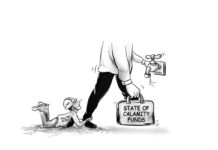BY SAMMY JULIAN
FLOODS are the most frequent type of natural disasters, causing widespread devastation, economic damages and loss of human lives.
In the past 30 years, the East Asia and Pacific Region accounted for about 40 percent of the total number of floods worldwide.
From 2000 to 2011, floods and storms in the region caused an estimated $23 billion in losses. In just the last five years, mega flood-events affected cities and countries around the world, including Bangkok, Hanoi, Ho Chi Minh City, Jakarta, Manila, Tacloban, Mumbai, Ulaanbaatar, Vientiane and Dakar.
In addition to the tragic loss of lives and economic losses, floods have long-term consequences such as loss of educational opportunities, disease and reduced nutrition which can erode development goals.
Like the many other megacities in the region, Metropolitan Manila has also suffered from severe flooding, especially over the last five years, bringing the entire metropolis to a halt and causing hardships to the population and disrupting economic activities
The impacts of floods hit the vulnerable segments of the population the hardest, disrupting their lives and pushing them into debt and poverty.
This is the reason why each and every nation in the world should consider disasters and urban flooding in particular to be a serious development challenge.
With this in mind, we are delighted to learn that this week, Manila will be hosting two international fora that will see senior representatives from national and local governments, international and regional organizations, humanitarian assistance organizations, non-government organizations and leading figures in the private sector reflect on their roles in the prevention of and response to disasters, as well as their contribution to recovery and rehabilitation efforts.
From June 3 to 5, the Third East Asia regional workshop on Flood Risk Management and Urban Resilience will be convened by over 70 delegates from East Asia, South Asia and Africa at the Discovery Suites in Ortigas Center, Pasig City.
This knowledge-sharing forum organized by the Philippine Department of Public Works and Highways, Metropolitan Manila Development Authority and the World Bank is designed to bring together decision-makers and government officials to discuss solutions for effective management of disaster risks in their cities.
Delegates include officials from national and local governments, development partners and experts from around 10 countries across these regions.
Through case studies about national and city-level projects, the event will highlight practical and operational knowledge and lessons learned from the Philippines and other countries around the world, including Bangladesh, China, Indonesia, Japan, Senegal and Thailand.
The participants will also visit a number of project sites to learn innovative approaches in flood control and disaster prevention adopted in Metro Manila. The gathering will help establish a community of leaders, practitioners and experts interested in promoting an integrated approach to flood risk management.
Meanwhile, from June 4 to 6, an estimated 150 delegates from Asia and Europe will converge in Manila to discuss how best to handle future mega-disasters.
Dubbed “The Asia Europe Meeting (ASEM) Manila Conference on Disaster Risk Reduction and Management: Post Haiyan- A Way Forward,” the conference is a Philippine initiative adopted by 49 Heads of States and Governments, the Presidents of the European Union (EU) and the Secretary General of the Association of Southeast Asian Nations (ASEAN) Secretariat comprising ASEM.
This international gathering will engage in earnest discussions and lively debates on whether current international practices and principles still hold in light of the Philippine experience with super typhoon “Yolanda.”
A sharing of best practices, innovation and technology for disaster risk reduction and management, as well as how best to reconstruct and rehabilitate devastated areas will also be themes for discussion in the four working groups of the ASEM Conference that will be chaired by the EU, the Philippines, Switzerland and Japan.
Also to be discussed are the following: application of innovation, science and technology to policy practice; strengthening the role of the state and other disaster risk reduction management stakeholders in disaster response and coordination; improving the international response system through specialization and coordination; and recovering from disasters and building back better communities.
Workshops like this facilitate global knowledge transfer, and help countries apply disaster and climate resilience principles in real-life development programs.
The two international gatherings will engage in earnest discussions and lively debates on whether current international practices and principles still hold in light of the Philippine experience with “Yolanda.”
We fervently hope that through these summits, we will all be provided with global knowledge and facilitate exchange between countries to learn from each other about their challenges as well as solutions that are available to them./PN



